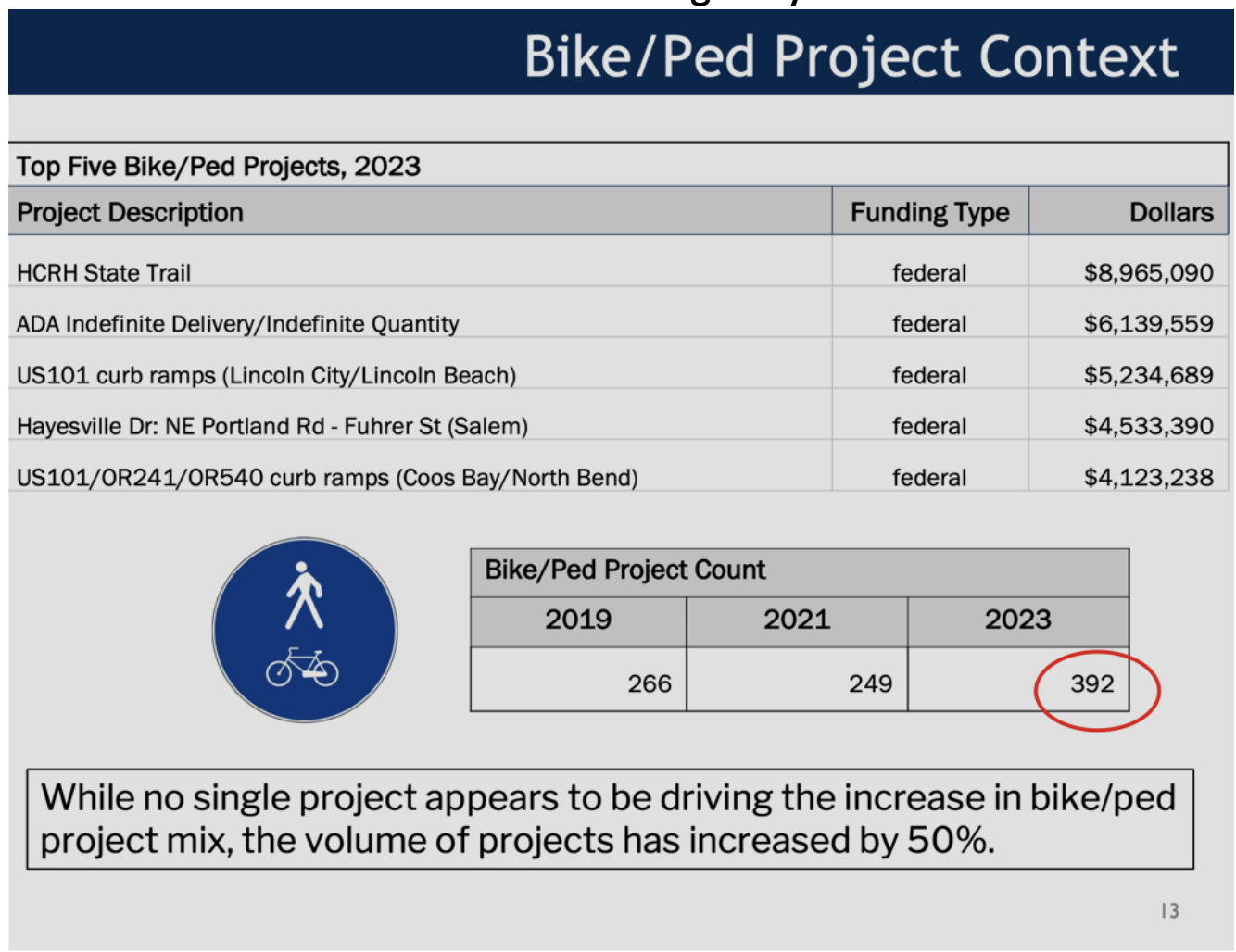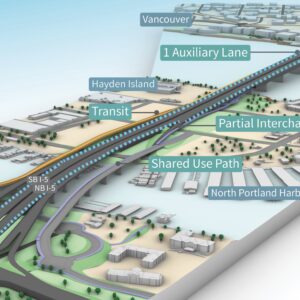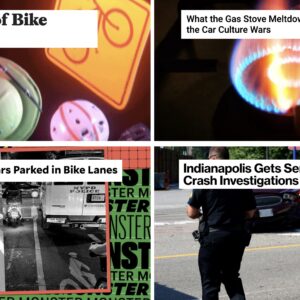An arcane study first undertaken by the Oregon Department of Transportation in 1937 is suddenly the subject of unprecedented scrutiny. The 2023-2035 Highway Cost Allocation Study (HCAS), published last year for the 23rd time and authored by research firm ECOnorthwest, is completed every two years in order to determine if road users are paying their fair share of taxes based on what ODOT spends on highways. If the balance is off, lawmakers and a study review team can use HCAS findings to lobby for changes in vehicle taxes and fees.
Its findings never made much news until now, because for the first time ever, it has revealed a significant imbalance.
The study, conducted by the Oregon Department of Administrative Services (DAS) splits vehicles into two main classes: light and heavy (over 10,000 pounds, which is essentially all large commercial freight trucks). The past two HCAS reports (completed in 2021 and 2023), have raised eyebrows because the numbers show light vehicle operators are not paying enough for what ODOT spends on them, and heavy vehicles operators are paying too much (see slide at right). “For the 2023-25 biennium, under the existing tax structure and rates,” reads page 45 of the study, “light vehicles are expected to underpay their fair share by 12% and heavy vehicles are expected to overpay by 32% relative to the projected distribution of project spending.”
The numbers validate concerns from trucking advocates who say they’re getting fleeced by taxes (that went up as part of the 2017 transportation funding package) and they’ve used the study to justify a lawsuit against ODOT filed earlier this month asking for a refund.
Why am I sharing this on BikePortland? Because the HCAS findings will likely have strong political impacts and ODOT spending on bicycle-related projects have already been singled-out as one of the reasons for the imbalance.



What ODOT chooses to spend its highway fee and tax revenue on (the “investment mix”) is how the HCAS determines whether or not road users are paying their fair share. The economists who work on the HCAS assign each type of expenditure — whether it’s highway maintenance, administrative and engineering overhead, or bike and pedestrian projects — a specific allocation percentage based on its benefit to light or heavy vehicle users.
What the latest HCAS shows is that ODOT has spent more money on things that benefit light vehicles owners, while the amount of taxes and fees paid by those vehicle owners has gone down — while the inverse is true for heavy vehicle owners.
On page 58 of the study, its authors write,
“Most notable is the shift toward increasing expenditures on bike and pedestrian-related projects… Bike and pedestrian investments have been increasing over recent years and the current HCAS includes nearly 400 bike and pedestrian projects, compared with approximately 250 projects in each of the previous two biennia.”
Given the oft-politicized transportation debates at ODOT and among trucking advocates at the Oregon Legislature, it’s easy to see how this factoid will be leveraged. And what’s at stake on a larger scale is how lawmakers respond to the current HCAS imbalance. Will they see it as a reason to cut fees on large trucks? Scale back investment on bike and ped projects? Charge more for car drivers and other light vehicle owners?
According to Joe Cortright, a Portland-based economist and co-founder of No More Freeways, blaming the imbalance on bike and pedestrian projects is one of three major “flaws” in the latest HCAS.
In a new post on City Observatory, Cortright says the imbalance is primarily caused by the decision to spend less on maintenance (like repaving and pothole repair) and more on freeway widening projects in the Portland metro area. This is because the planning and engineering costs for freeway expansion projects (which have gone up in recent years) count toward light duty vehicles in the HCAS formula, and maintenance projects (which have gone down) count toward heavy vehicle expenditures. Spend more on maintenance and repaving roads, and less on expanding freeways, Cortright says, and, “ODOT could reduce or resolve the cost- responsibility problem.”
Cortright also thinks the state’s use of federal funds in HCAS project expenditure calculations goes against Oregon’s Constitution. “Nothing in the law or constitution directs or authorizes including federal funds in the HCAS calculations,” he writes. DAS also tallies major federal funding for bike and ped projects in the HCAS (see slides above), which Cortright says is not only illegal, but further tilts the balance of blame.
ODOT Communications Director Kevin Glenn told BikePortland the decision to include federal funds was made by the nine members of the HCAS Study Review Team and has been their methodology since 2003. Glenn also says that while it’s true that more spending on maintenance would correct the imbalance, “We don’t really have the ability to do so with our current funding structure.” “We would certainly like to spend more on maintaining our facilities,” Glenn wrote in an email after this post was published. “But because of legal restrictions on how we both receive our funding and how we can spend it, there aren’t a lot of places we could pull from to fund additional maintenance work.”
Findings from the HCAS have already led to the aforementioned lawsuit by the Oregon Trucking Association. And now two Republican lawmakers in Salem have sponsored bills to decrease the weight-mile tax charged to trucks. House Bill 4165, sponsored by Rep. Shelly Boshart Davis (R-15)*, requires ODOT to complete a report and recommend legal changes that would balance the “transportation responsibility cost” between light and heavy vehicles. Senate Bill 1519, sponsored by Senator Brian Boquist (R-12), seeks to lower the weight-mile tax, issue refunds to taxpayers who overpaid, and would set specific limits on how highway funds could be spent.
Both bills have their first public hearing in front of the Joint Committee on Transportation this Thursday (2/15) at 5:00 pm.
*Rep. Boshart Davis is a member of the family that owns Boshart Trucking, Inc.
Note and corrections, 2/26: This story has been edited with comments from ODOT’s Kevin Glenn and has been corrected to change the author of the study from ODOT to the Department of Administrative Services.
— Learn more about the HCAS in the interview with Cortright below, which I recorded last week.








Thanks for reading.
BikePortland has served this community with independent community journalism since 2005. We rely on subscriptions from readers like you to survive. Your financial support is vital in keeping this valuable resource alive and well.
Please subscribe today to strengthen and expand our work.
I want to call out the way that the ODOT report discusses the increase in “bike and pedestrian projects”, without attempting to explain where that increase comes from. That’s unfortunate, because it leaves the door open for all kinds of speculation that feeds into the tired old “bike users are not paying their share” narrative.
Glancing at the top 5 projects, it looks like well over half of those project dollars are for ADA ramps. Many, perhaps most, of the increase in projects come directly from the AOCIL settlement that successfully forced ODOT to start installing ADA ramps and ped signals across the state. The annual report mentions $700M in allocations over the next 5 years.
I sometimes joke that most “bike/ped projects” would be better described as “car mitigation projects”. This is a prime example. By lumping together legally mandated accessibility requirements into “bike and pedestrian projects”, ODOT is feeding the false perception that we are spending lots of money on optional bike paths that only some people will use for recreation. The fact is that vast majority of these dollars are going to make basic improvements to complete our infrastructure, simply so that people can safely travel on a sidewalk or cross a busy street. Unless we conditionally value human life, these projects are not optional. They are a critical component of building and maintaining any road, and the increase spending is only a reflection of ODOT’s past dereliction.
If, “light vehicles are responsible for for most of the costs of project types like bicycle paths,” and also, “registration and vehicle sales for light vehicles remain below pre-pandemic levels while trucking activity is up,” doesn’t it follow that heavy trucks take on a greater share of responsibility for bike and pedestrian projects as they account for a greater share of traffic?
I wish the PNW communities were stricter about having all commercial vehicles with their weights marked on both sides of the vehicle like Hawaii does. It makes this type of discussion a little easier to see ‘out on the streets’ and highways (and to monitor if too heavy of vehicles stay and cut thru into inappropriate routes.)
Glad I never had to pay freight taxes on my long bed bakfiets. 😉
Freight/trucking complain about the traffic bottleneck that is Portland traffic and they complain about the proposed projects that would address that congestion as if they would not benefit from the projects they are asking for.
During the 90s Freight lobbying persuaded the legislature to lower weight restrictions on Oregon bridges. The result is that many dozens of bridges cracked and needed to be replaced at the cost of hundreds of millions of dollars. Trucks cause the greatest damage to infrastructure and despite their complaints, they don’t pay their share of costs.
Methinks ODOT calls out their expenditures on bike and ped projects to burnish their green credentials – as they do absolutely everything possible to encourage fossil-fueled transportation.
But I guess I am cynical.
Nice video by JM and Joe. Would it be possible to turn off the word-by-word captioning? Looks like that captioning is on BP’s end – separate from YouTube captioning. Thanks.
yes in future videos I won’t burn in my own captions. I’m still learning how to make these really good and making tweaks and improving every day! In future you won’t see captions unless you toggle the CC button. Thanks for the feedback.
Thanks! I think there’s a way for you to upload captions to YouTube, since the auto-generator makes a lot of mistakes (but it’s getting better). Then you give the user the choice of having captions, or not.
But heavy truck owners and merchants pass those costs directly to consumers plus a surcharge of their own.
In addition, studies have shown every heavy truck damages roads over 200 times more than a passenger car.
In other words, freight fees are regressive (acting much like a sales tax).
I have no intuition for what arrangement is “fair” (if that concept can even be applied to this context), so I’d support whichever politically and technically feasible policy for paying for our infrastructure would be most effective from an emissions reduction perspective that also doesn’t involve tracking people’s movements.
Seems like the majority of the justification for I-5 bridge replacement and Rose quarter freeway expansion that people such as secretary buttigieg make is based on freight movement (https://www.opb.org/article/2024/02/12/transportation-secretary-pete-buttigieg-says-i-5-bridge-replacement-will-happen/?outputType=amp). Therefore, it stands to reason that those projects should be classified as freight projects
That being said, I think the declining revenue from passenger vehicle taxes and fees is a serious issue. People are being allowed to forgo registering their vehicles, gas taxes aren’t keeping up with inflation, and nothing is being done to charge electric vehicles on a per mile basis to replace the gas tax. Further, the 2017 bill that instituted the heavy truck fee also envisioned tolling of passenger vehicles. The tolling plan was put on an indefinite back burner by governer kotek. I think there’s a legitimate argument that passenger vehicles are being undercharged, but I don’t think you can argue that heavy vehicles are being overcharged.
I think it would probably be a positive outcome if the freight lobby is successful in clawing back money from odot to the extent that they don’t have enough money to do freeway expansion projects. So I wish them the best of luck in their suit. But I think the grounds for it are specious.
Unfortunately this data will play right into the hands of the people claiming cyclists don’t pay their fair share for bike infrastructure – and perhaps this is even an indication they might be correct.
What is a bike rider’s “fair share” of the cost of maintaining roads? What is their fair share of using the library or park or sending their kids to public school? Why should gas tax be constitutionally walled off from being used to pay for, say, education when cigarette taxes aren’t?
There may be policy goals we want to pursue through tax policy, but I really have no idea how “fair” should work in this context.
If we want to talk about “fair” we have to acknowledge that all of us, no matter how we get around personally, fuel demand for goods from outside our area that drives the freight industry.
Therefore we *all* are responsible for the damage that industry does to the roads.
In a fair system we would use a progressive funding method for road upkeep and road improvements (including improving access for those of us who don’t/can’t drive).
Even the most vocal of active transportation advocates have to admit this doesn’t look good. The political winds are entirely at the backs of the freight industry right now. To add insult to injury all you have you to do is watch the news coverage of US Secretary of Transportation Pete Buttigieg’s visit to the I-5 Interstate Bridge yesterday with WA Governor Jay Inslee & OR Governor Tina Kotek. Pete, Jay & Tina were absolutely gushing praise about the IBR project in front of any camera that would listen. I would say the dissenting voices on the IBR and Rose Quarter projects are rapidly moving toward mere background noise in the political reality we’re currently living in.
Try not to sound too happy
thank you random citizen that is definitely objective in their analysis and not working for ODOT or the highway lobby
It’s a long document that I can’t be bothered to read all the way through, so maybe somebody else can help me out here.
I see a lot of talk about vehicles and percentages and what is fair.
What I’m not seeing is the cost per pound per mile that people are paying.
It’s my expectation that heavy vehicles pay more, but what exactly is their fair share? Are they paying way more for the miles-per-pound that they’re putting on the roads?
Are they even tracking the actual weights of the vehicles, or just counting all semi trucks the same? It looks like there’s just light and heavy, and not any accounting of the real weights. Light vehicles aren’t going to go over 10,000 lbs, sure, but what’s the max weight of a fully loaded triple trailer rig?
Here is the Mileage Tax Rates for Oregon
https://www.oregon.gov/odot/Forms/Motcarr/9928-2022.pdf
All Carriers or Operators must keep track of the mileage driven in Oregon and the declared weight for each trip. Taxes must be paid at the end of each month, unless they request to pay on a quarterly basis. So the state should know the miles-per-pound for all commercial vehicles driving on Oregon roads. Weigh Stations are just a spot check to verify compliance.
What does “light” mean? Is that my ’99 compact sedan (which is driven seldom) or is it the behemoth SUV that weighs more than twice what my sedan does?
light is anything under 10,000 pounds